Japanese Learners' Study Habits Survey Results
This article presents the results of a survey on Japanese learners' study habits and analyzes the demographic, their motivations, the tools they use, and how long it takes them to reach a certain level.

This article presents the results and analysis of a survey on Japanese learning habits. The 598 respondents have learned Japanese (23) or are still learning (575).
Disclaimer
A majority of the respondents came from Reddit so the demographic of this survey exhibits a bias toward the demographic of Reddit in general. This might not be an accurate depiction of the broader population of Japanese learners but still gives us some insights into a population of English speakers using apps and online tools to study Japanese.
Demographics
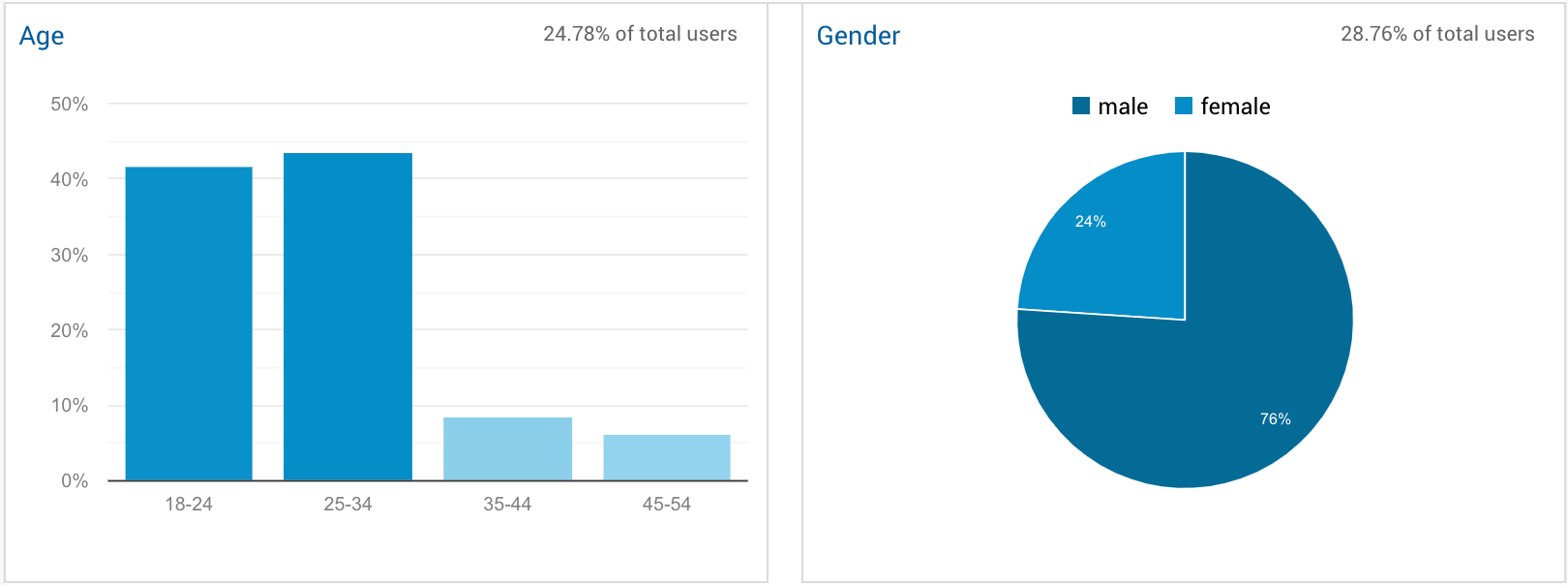
The age and gender demographic statistics were anonymously collected with Google Analytics from a sample (between 25% and 29%) of the visitors to the site, disregarding whether they took the survey or not. The language and country were inferred from their browser's settings and might not reflect the mother language of the visitor.
The average visitor is a male (76%), between 18 and 34 years old (82%), whose most common native language is English (75.8%) followed by Japanese (5.4% this could be due to visitors using a computer in Japanese, for instance at school), French (4.4%), German (3.9%), Spanish (2.6%), Portuguese (2%) and other languages (5.9%).

People are broadly spread geographically, with 37% from North America, 31% from Europe, 18% from East and Southeast Asia, 6% from South America, 4% from Southern and Western Asia, and 3% from Australia.
9% of visitors were in Japan while 6% of the survey respondents said they were currently living in Japan.
Relation Between Years of Studies and JLPT Level

The majority of learners (53.2%) have less than one year of study, with a 5th of respondents just getting started. 10.2% have been studying for more than 5 years.
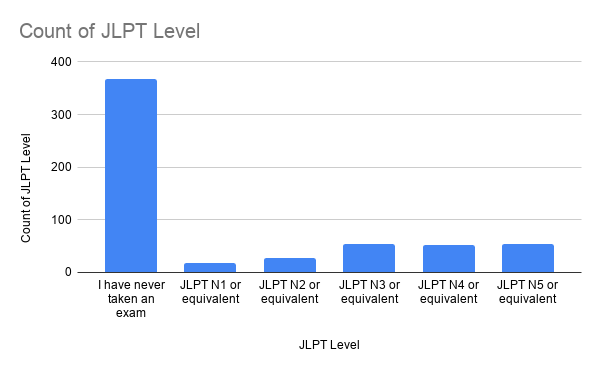

The cross-reference shows a correlation between JLPT level (or equivalent) and the number of years studying. Only 23.5% of beginners (less than a year studying) took or can compare their level to the test. This number increases as the time passes, 52% of intermediate to advanced learners took the test (or estimated their level), and a whopping 75.4% of long term learners (> 5 years).
The number for absolute beginners (less than 3 months) seems unreliable. Considering many answered to have a level equivalent to JLPT N1 (the hardest level), it seems they have wrongly assumed it was the easiest level. 7.4% estimate to have reached a level equivalent to N5 in less than 3 months which seems plausible if they took one term of intensive class (15~20 hours/week).
The majority of learners who studied for less than a year can still be considered beginners or lower intermediate with an equivalent level of N5 for 14.3% and N4 for 6.1%. Only 1.5% estimate to have attained an intermediate level (N3 equivalent) in less than a year.
Half the students between 1 to 5 years of studies self-reported as beginners (7.1%), lower intermediate (18.4%), intermediate (17.9%), and upper-intermediate (7.7%).
Only after more than 5 years of studies does the number of advanced learners reach a significant 19.7% (JLPT N1 or equivalent), while the majority still consider themselves intermediate (6.6% lower, 26.2% intermediate, 18% upper) and only a few remaining at a beginner level (4.9%).
Higher Level For Course Takers


Those numbers are much higher for respondents who are taking classes compared to those who aren't, especially for JLPT N4 and N5.
For the respondents who studied less than 3 months, those who took a course were 4 times more likely to reach a level equivalent to JLPT N5 compared to those who never took a class (17.2% vs 4.3%).
Likewise, 3 times more people reached JLPT N5 in less than a year after taking a class (25% vs 8.5%). The same observation for JLPT N4 with 13.2% of course takers compared to only 3.1% who never took a course. The number is even more staggering for JLPT N3 students, only those who took a class could reach that level (4.4%) in less than a year.
This trend is still observable after a year of studies, 9.6% of course takers attained JLPT N2 against 3.8% who didn't take a class. The only exception to that trend is for JLPT N1, a few more people reached that level without taking any course. This discrepancy might be due to the low number of samples in this category.
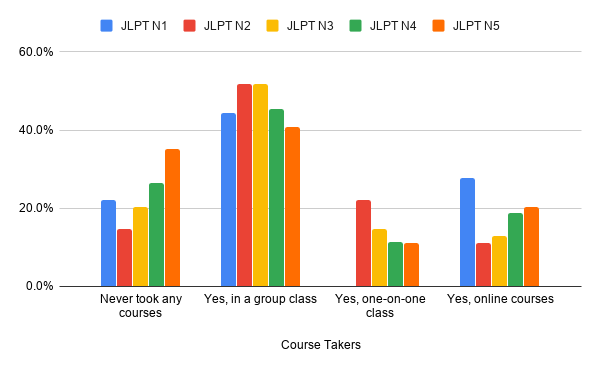
About half of the respondents who passed any level of JLPT have had taken a group class. The higher the level, the more likely the student took a group class. Students at lower levels are more likely to have taken online courses instead.
Study Frequency and Location
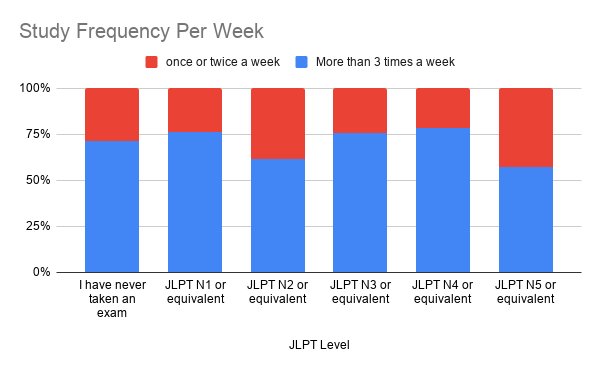
About 2/3 of the respondents are studying more than 3 times per week, this seems consistent across all levels except for beginners.

The overwhelming majority of respondents are studying at home (68%), followed by commuters (13.4%).
Motivations to Learn Japanese
80.6% of the respondents are learning Japanese because they love the Japanese culture.
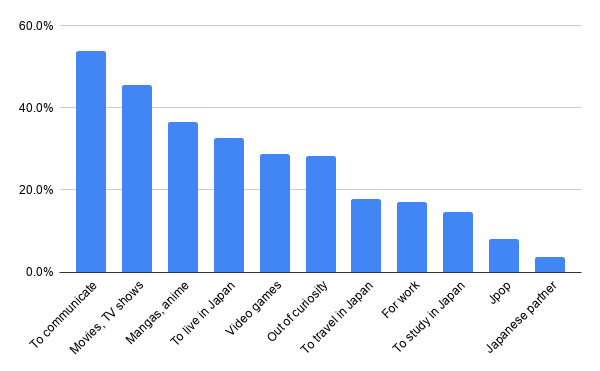
The interest in pop culture is predominant, with 73.7% of the respondents showing interest in at least manga, anime, movies, drama, TV shows, video games, or Jpop.
The second major reason seems to be a practical one for 61.9% of respondents: to live (32.6%), travel (17.9%), work (17%) or study (14.7%) in Japan. Note that the "for work" answers do not discriminate between those working in Japan or outside, but even if we remove them, the number of people who want to learn Japanese to visit or live Japan is still 54.7%.
The will to communicate with Japanese people comes in third position (53.8%).
There is also 28.3% learning out of curiosity, driven by an interest in the Japanese culture or the language.
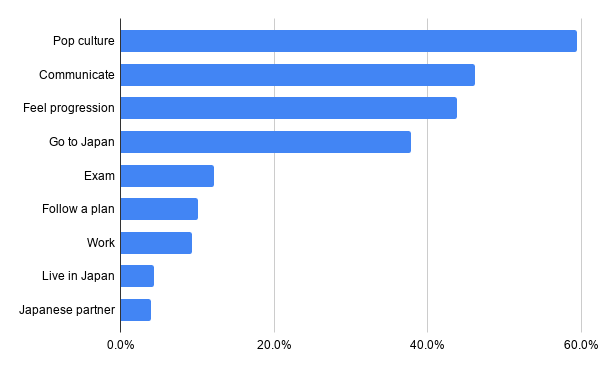
As for what keeps them motivated, the number one reason (59.4%) is in line with the reason to start learning: enjoying pop culture (manga, drama, etc.). And so is the ability to communicate with Japanese people (46.2%).
43.8% of the respondents said that the feeling of making progress keeps them motivated. The fourth major motivator (37.8%) is a plan to go to Japan.
Less respondents are motivated by necessity rather than pleasure: study/exam (22.%) and work (9.4%).
The reason at the bottom of the ranking is quite surprising. Despite 32.6% living or wanting to live in Japan, this only motivates 4% to keep studying.
Kanji Learning
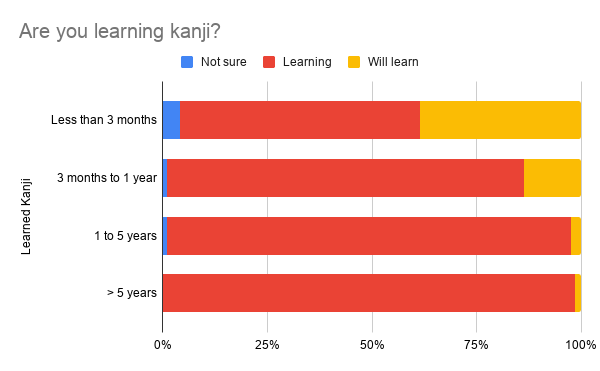
57.4% of learners are already studying kanji during their first 3 months, 85.2% after 3 months, and 96.4% after the first year.
Study Tools
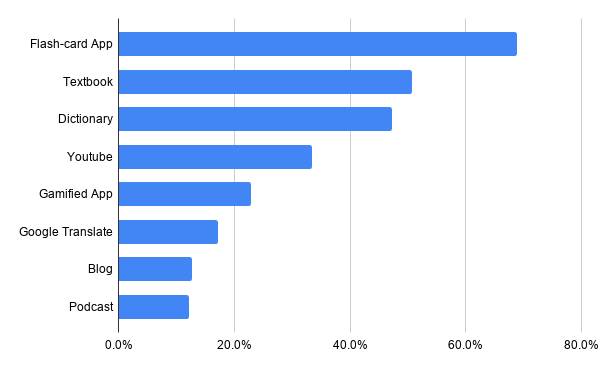
By far, the most popular study tools are flash-card apps (Wanikani is also include in this category) with 68.9% of respondents using them, far more popular than other gamified apps (such as Duolingo) only used by 22.9%.
Traditional textbooks are used by 50.7%, slightly less than all formats of online lessons combined (youtube videos, blog articles, podcasts) that are used by 58.4%.
Translation Tools
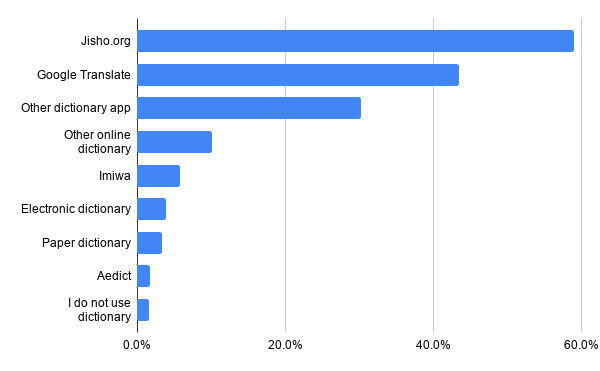
The majority of respondents (76.6%) use a dictionary (any format) to search the translation of a word. 17.6% exclusively use Google Translate for that usage, while only 1% use neither.
Among dictionary users, online dictionaries are the most popular (82.5%), especially jisho.org with 85% of users.
The second most used kind is the dictionary app (47.1%), followed by electronic dictionary (5.1%), then paper dictionary (4.3%).
Kanji Input Methods
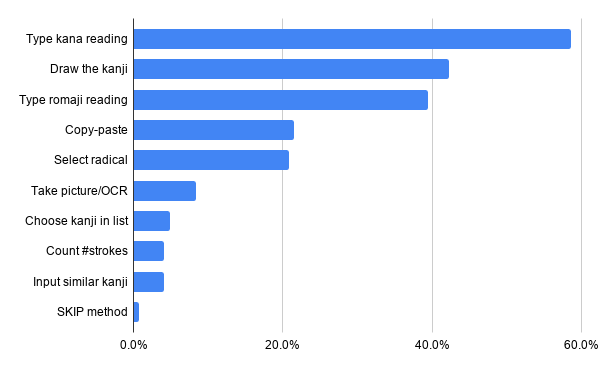
By far, the most used kanji input method is searching by reading (83%) either in kana (58.6%) or romaji (39.4%). Which is also the standard method for natives.
The second most used input method is drawing the kanji, for 42.3% of respondents. Useful when the reading is unknown or forgotten. An alternative to drawing is selecting the radical or components from a list (20.8%).
Other methods are used when the kanji can't be drawn or read, mostly by copy-pasting it from another website (21.5%) or a list (4.8%), using an OCR (8.4%), or looking up a similar kanji one already knows (4.1%).
Traditional dictionary lookup methods such as stroke counts (4.1%) or SKIP method (0.7%) seems rarely used, except by paper and electronic dictionary users.
Conclusion
This studies has shown that Japanese learners are mainly studying for pleasure rather than for a career. The main motivation to study the language is to enjoy pop culture (manga, games, TV shows, etc.), a plan to go to Japan, and communicate with Japanese people. Few are doing it for work. Pop culture is still the main reason that keeps people motivated. Despite a third of the respondents wanting to live in Japan as a reason to start learning, very few said that it is what kept them motivated in the end.
The majority are self-learners, combining flash-card apps and online resources, studying at home or during their commute, at least 3 times per week. Despite that, the study reveals a clear advantage to those taking a course, and especially in a group class. They are 3 to 4 times more likely to attain a level equivalent to JLPT N5 to N3 in the same amount of time than those not attending classes. This number might be biased though, due to the school encouraging students to take the JLPT exam, or at least giving them a better understanding of their actual level.




